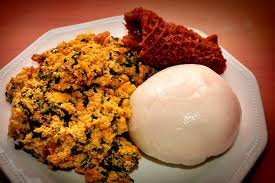Pounded yam is a beloved dish in West Africa, especially in Nigeria and Ghana, where it is often paired with rich and flavorful soups like egusi, ogbono, and vegetable soup. Traditionally, pounded yam is made by boiling yam tubers and pounding them into a smooth, stretchy consistency. However, with the advent of pounded yam flour, making this dish has become significantly more convenient. Choosing the best pounded yam flour is crucial for achieving the perfect taste and texture. This article provides a comprehensive guide to selecting high-quality pounded yam flour for your meals.
1. Understand What Pounded Yam Flour Is
Pounded yam flour is a processed alternative to traditional pounded yam. It is made by drying and grinding yam tubers into a fine powder. When mixed with hot water, the flour transforms into a smooth and stretchy dough-like consistency, closely resembling the traditionally pounded yam. The best flour should be free from additives and preservatives while maintaining the authentic taste and feel of real pounded yam.
2. Check the Ingredients List
The first step in choosing the best pounded yam flour is to examine the ingredients. A high-quality product should contain 100% yam without any artificial additives, starch, or preservatives. Some brands mix yam with other flours like cassava or potato starch, which can alter the texture and taste. Always read the label carefully to ensure you’re getting pure yam flour.
3. Consider the Processing Method
How the flour is processed plays a significant role in its quality. The best pounded yam flour is made using minimal processing, which helps retain its natural nutrients and flavor. Some key things to consider include:
- Sun-dried vs. Machine-dried: Sun-dried yam flour often has a richer taste, while machine-dried options might be more consistent in texture.
- Fine Grinding: A well-processed flour should be finely ground to avoid lumps when preparing it.
- No Chemical Additives: Some manufacturers add preservatives or bleaching agents, which can affect the quality and health benefits of the flour.
4. Look at the Color and Texture
Quality pounded yam flour should have a creamy white color, similar to fresh yam. If the flour appears too white or has a chalky consistency, it may contain added starch or whitening agents. The texture should be fine and smooth, which ensures easy mixing with hot water to form a lump-free consistency.
5. Consider the Taste and Aroma
Authentic pounded yam flour should have a mild, natural yam aroma. If the flour has an unusual or synthetic smell, it may have been chemically treated. A good test is to prepare a small portion and taste it. The flavor should be close to that of freshly pounded yam without any bitterness or artificial aftertaste.
6. Test the Stretchiness and Smoothness
One of the essential qualities of good pounded yam is its stretchiness and smoothness. When prepared correctly, it should not be lumpy or grainy. High-quality pounded yam flour will yield a dough that stretches easily without breaking apart. If the flour produces a rough or crumbly texture, it may contain too many additives or be of poor quality.
7. Check for Nutritional Value
Pounded yam flour is a carbohydrate-rich food, but some brands offer additional nutritional benefits. Look for flours that retain essential vitamins and minerals such as potassium, fiber, and vitamin C. Avoid brands with excessive starch or fillers that reduce nutritional value. If you are health-conscious, opt for organic or naturally processed options that maintain more nutrients.
8. Brand Reputation and Reviews
With many brands available on the market, it’s crucial to research before purchasing. Look for well-established brands known for producing high-quality pounded yam flour. Reading customer reviews online can help you determine the reliability of a particular brand. Pay attention to reviews that mention:
- Texture and consistency after preparation
- Authenticity of taste
- Presence of additives or preservatives
- Overall customer satisfaction
9. Packaging and Storage
The packaging of pounded yam flour can affect its freshness and longevity. Choose flour that comes in airtight, moisture-proof packaging to prevent contamination and spoilage. Poorly packaged flour can absorb moisture and develop mold or an off-putting smell. Once opened, store the flour in an airtight container in a cool, dry place to maintain its quality.
10. Price vs. Quality
While it might be tempting to go for the cheapest option, quality should be your top priority. Extremely cheap pounded yam flour may be mixed with other starches or low-quality yams. That said, the most expensive option is not always the best either. Compare different brands, check ingredients, and read reviews to ensure you’re getting good value for your money.
11. Availability and Accessibility
Some brands of pounded yam flour are more widely available than others. Depending on where you live, certain high-quality brands may be hard to find in local stores. In this case, you might want to explore online options. Many reputable African food stores and online marketplaces like Amazon and local specialty grocery shops stock a variety of brands.
12. Special Dietary Needs
If you have dietary restrictions, you should be mindful of the type of pounded yam flour you purchase. Some options cater to specific needs, such as:
- Gluten-Free: Pure pounded yam flour is naturally gluten-free, but always check the label to ensure there’s no cross-contamination.
- Low-Carb Alternatives: Some brands blend yam with other low-carb ingredients for a healthier option.
- Organic and Non-GMO: If you prefer food without chemical processing, look for organic-certified pounded yam flour.
13. Experiment with Different Brands
Since different brands offer varying levels of quality, you might need to try a few before settling on your favorite. If possible, buy small packs of different brands and compare their taste, texture, and consistency. Once you find the best one, you can purchase in larger quantities.
Conclusion
Choosing the best pounded yam flour for your meals requires careful consideration of several factors, including ingredients, processing methods, texture, taste, and brand reputation. Always opt for pure yam flour with no additives, and pay attention to its color, aroma, and consistency when prepared. By doing your research and testing different brands, you can enjoy the convenience of pounded yam flour while still savoring the authentic taste and texture of traditional pounded yam. Whether you’re a seasoned cook or a beginner, selecting the right pounded yam flour will ensure you create a delicious and satisfying meal every time.



